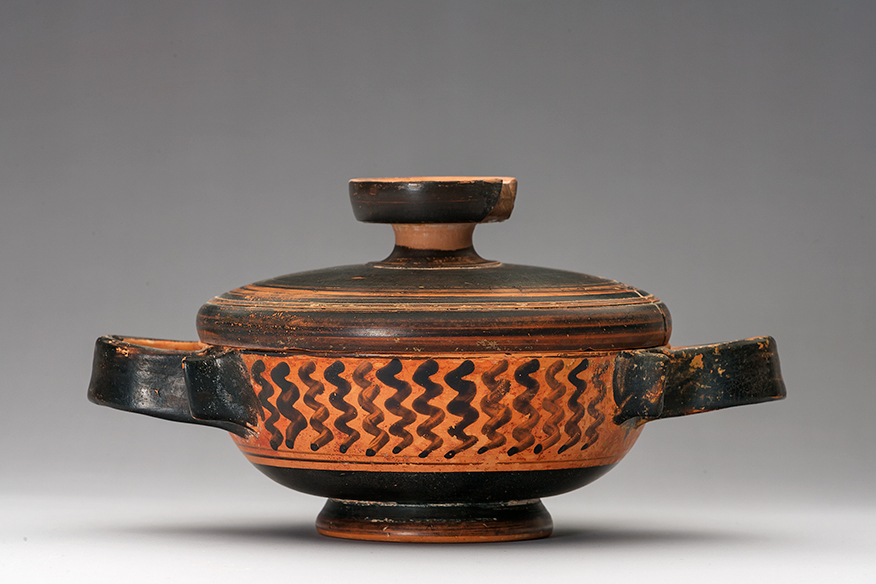Acquisition number: 1976.11
Boeotian Lekanis and Lid.
The lid has been broken and a chip is missing from its handle, but the bowl is intact. Orange-buff clay with some fine mica.
The lid is slightly domed; there is a groove towards the edge of the shoulder and a step at the base of the handle stem; the top of the handle is slightly recessed. Somewhat streaky black glaze.The latter is reserved, reddened and decorated with circles about a central dot. But for a reserved band about the stem and another on the edge of the lip, the rest is black including the inner face. The inner face has particularly streaky glaze which makes it evident that it was applied with the piece standing on a wheel.
The body has spurred band handles and a lip which has its horizontal member recessed to receive the lid. Carefully made ring foot, curved on both inner and outer faces. The inside is black, again done on the wheel. The lip has a band on its vertical face. The outer faces of the handles are black but on the body between them are reserved panels decorated with vertical wavy lines with a fine horizontal line below. The lower wall and the inner and outer faces of the foot are black. The resting surface and the underside of the floor are reserved, the latter decorated with concentric circles about a central dot. All the reserved surfaces are reddened, including the inner faces of the handles.
Title: Boeotian Lekanis and Lid - 1976.11
Acquisition number: 1976.11
Author or editor: J.R. Green
Culture or period: Greek Classical.
Date: Late 5th - early 4th century BC.
Material: Clay - Terracotta
Object type: Vessels - Dish/plate
Dimensions: 145mm (w) × 110mm (h)
Origin region or location: Greece
Origin city: Boeotia.
Display case or on loan: 4
Keywords: Greek, Classical, Boeotian
J.R. Green with B. Rawson, Catalogue of Antiquities in the Australian National University, A.N.U. (Canberra, 1981) 46.
1976.11
Boeotian Lekanis and Lid
Lent to University House by Mr H.B. (“Joe”) Gullett and then lent by University House to the Classics Museum with Mr Gullett’s approval. Total ht 11cm; ht of bowl 6.6cm; diam. bowl 14.5cm; ht of lid 5.1cm; diam. lid 14.5cm.
The lid has been broken and a chip is missing from its handle, but the bowl is intact. Orange-buff clay with some fine mica.
The lid is slightly domed; there is a groove towards the edge of the shoulder and a step at the base of the handle stem; the top of the handle is slightly recessed. Somewhat streaky black glaze.The latter is reserved, reddened and decorated with circles about a central dot. But for a reserved band about the stem and another on the edge of the lip, the rest is black including the inner face. The inner face has particularly streaky glaze which makes it evident that it was applied with the piece standing on a wheel.
The body has spurred band handles and a lip which has its horizontal member recessed to receive the lid. Carefully made ring foot, curved on both inner and outer faces. The inside is black, again done on the wheel. The lip has a band on its vertical face. The outer faces of the handles are black but on the body between them are reserved panels decorated with vertical wavy lines with a fine horizontal line below. The lower wall and the inner and outer faces of the foot are black. The resting surface and the underside of the floor are reserved, the latter decorated with concentric circles about a central dot. All the reserved surfaces are reddened, including the inner faces of the handles.
The lekanis was a standard table container for small objects and as such the lid was regularly made so that it would stand inverted. For a study of the shape and its chronology, see E.D. Breitfeld - von Eickstedt, “Die Lekanis vom 6.-4. Jh. v. Chr. Beobachtungen zur Form und Entwicklung einer Vasengattung”, in: J.H. Oakley, W.D.E. Coulson and O. Palagia (eds), Athenian Potters and Painters: The Conference Proceedings (Oxford 1997) 55-61, although she concentrates on Attic examples.
This piece is a good example of Boeotian work of the late fifth or early fourth centuries BC. For a good introduction to Boeotian pottery, see the lively treatment by B.A. Sparkes, “The Taste of a Boeotian Pig”, Journal of Hellenic Studies 87, 1967, 116-130. J.-J. Maffre gave a sound and thorough treatment of the not inconsiderable number of Boeotian vases in the Kanellopoulos collection in Bulletin de Correspondance Hellénique 99, 1975, 409-520, with Bulletin de Correspondance Hellénique 102, 1978, 263-284. Both authors provide full references to earlier work. See also A. Waiblinger, Corpus Vasorum Antiquorum Louvre (17) and, more recently, V. Sabetai, Corpus Vasorum Antiquorum Thebes (1); for red-figure, C. Avronidaki, Ο Ζωγράφος του Άργου: συμβολή στην έρευνα της βοιωτικής ερυθρόμορφης κεραμικής στο β’ μισό του 5ου αιώνα π.Χ. (Athens 2007).
J.R. Green with B. Rawson, Catalogue of Antiquities in the Australian National University, A.N.U. (Canberra, 1981) 46.
University House, Australian National University.
1 Balmain Cres, Acton ACT 2601.
(02) 6125 5211.
